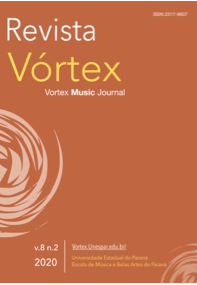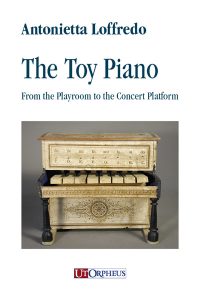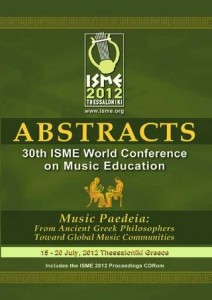PUBBLICAZIONI
“THE TOY PIANO IS NOT A TOY”
in Revista Vórtex | Vortex Music Journal
v.8 n.2, 2020 | ISSN 2317–9937
Dossiê | The Toy Piano Takes the Stage
Abstract: this paper describes a two-day composition workshop dedicated to the toy piano held in 2019 at a state middle school with a musical address in Italy. Eight young pupils in the early years of their piano studies took part. The resulting compositions are shown and indicate that the toy piano is a useful means to stimulate creativity in young pupils. A further consideration addressed is that operating in the educational field means expanding the future audience with respect to new musical languages and means of musical expression. In discussing both pedagogical practise and composing and performing, the author’s aim is to contribute to the comprehension of the ‘toy piano phenomenon’ which in recent years has increasingly seen this instrument take centre stage on the contemporary music scene
• http://vortex.unespar.edu.br
“THE TOY PIANO. FROM THE PLAYROOM TO THE CONCERT PLATFORM”
Description
In 1948, John Cage offered the public his Suite for Toy Piano. Performed at Black Mountain College (North Carolina), with choreography of dancer Merce Cunningham, it later became a solo instrumental piece and the point of reference for all musicians dedicated to the art of the toy piano. This little piano was different from the standard piano both for its small dimensions and for its sound produced by hammers striking different length metal rods.
Into the first decade of the 21st century, several cultural and musical initiatives around the world have increased and spread repertoire dedicated to the toy piano, making it a key player in the contemporary music scene.
All aspects of the toy piano are discussed in this book which offers a comprehensive source of information to those interested in widening their knowledge of this topic. After detailing the origin of the toy piano, its constructive characteristics and its challenging acoustic behaviour, the book provides an extensive overview of the scored repertoire, as well as an analysis of the cultural contexts which saw the toy piano continue the tradition of toy instruments in art music.
Product Details
Author: Antonietta Loffredo
Publisher: Ut Orpheus Edizioni (2018)
Language: English
Pages: pp. 172
Size: 140×210 mm
Binding: Paperback (Soft Cover)
ISBN: 978-88-8109-511-7
Code: LB 34
“TECNICHE NON CONVENZIONALI NELLA DIDATTICA DEL PIANOFORTE”

in Musica Domani
n. 168/169 – settembre/dicembre 2013
“Spesso l’esplorazione del pianoforte si ferma alla ricerca della stranezza sonora fine a se stessa, senza cogliere le potenzialità tecniche ed espressive delle modalità di produzione del suono che esulano dalla tecnica tradizionale. L’autrice fornisce spunti didattici e indicazioni di repertorio per approfondire l’approccio esplorativo: presenta una panoramica delle tecniche pianistiche contemporanee basate su una stretta relazione fra qualità del gesto e feedback sonoro, ne rintraccia esempi nella letteratura pianistica più recente rivolta ai principianti e suggerisce percorsi incentrati su di esse.”
“EXTENDED TECHNIQUES IN PIANO PEDAGOGY”
30th ISME World Conference on Music Education
15-20 July, 2012 Thessaloniki, Greece
ABSTRACT Starting from the early 20th century,unconventional use of the instrument has been introduced in piano literature by various composers, such as Henry Cowell (1867-1965) and Jhon Cage (1912-1992). Nowadays, ‘extended techniques’ have also been largely assumed as useful tools to introduce pupils to make music from the beginning of their piano study […].
Workshop presented at the 30th ISME World Conference.
“COMPOSITORI SU MISURA”
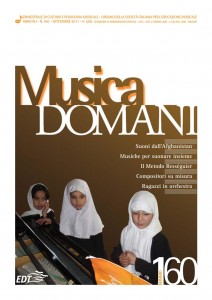
in Musica Domani
n. 160 – settembre 2011
“L’articolo illustra l’esperienza svolta nel corso di tre seminari tenuti dall’autrice presso il Conservatorio “G. Tartini” di Trieste e presso il Conservatorio “F.A. Bonporti” di Trento, seminari destinati alla scrittura di brani cameristici utili alla promozione della musica d’arte contemporanea in ambito didattico.”
“CHAMBER MUSIC: TEACHING PROGRAMS AND CHOICE OF REPERTOIRE”

29th World Conference of the International Society for Music Education
1-6 August, 2010 Beijing, China
ABSTRACT This paper recounts the experience gained during two seminars held by the author in Italy at the “G. Tartini” conservatoire in Trieste and the “F.A. Bonporti” conservatoire in Riva del Garda (a branch of the Trento conservatoire), both directed at the composition of pieces designed to promote contemporary music in an educational environment. The compositions were all created within the context of chamber music, given its particular educational value. […]
“MUSICA E SCUOLA” – GIOIOSA EDITRICE
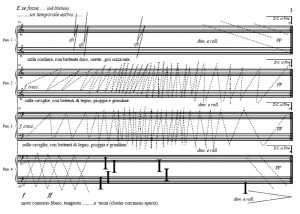
Mare d’Oriente, brano per pianoforte a otto mani di Marina Masiero pubblicato sulla rivista “Musica e Scuola” del mese di settembre 2007.
Dal dicembre 2005 al novembre 2009 Antonietta Loffredo ha realizzato gli inserti mensili sul “Repertorio contemporaneo nella didattica dello strumento” sulla rivista “Musica e Scuola”.
Sono state pubblicate cinquanta nuove composizioni, corredate da brevi note descrittive. Tutti i brani, dedicati ai primi anni di studio e con particolare riguardo alla musica d’insieme, sono stati il frutto della collaborazione dell’autrice con colleghi e studenti delle classi di composizione dei Conservatori di Trento, Trieste e Riva del Garda.
From December 2005 to November 2009 Antonietta Loffredo collaborated with the music magazine “Musica e Scuola”. She wrote monthly inserts about “Contemporary repertoire in teaching instrumental music”.
More than fifty music pieces were published followed by her comments and analysis and were the result of the author’s collaboration with colleagues and students from the Conservatoires of Trieste, Riva del Garda and Trento.
All of these compositions were written for young performers with particular attention to chamber music.
“CONTEMPORARY MUSIC IN PIANO PEDAGOGY”
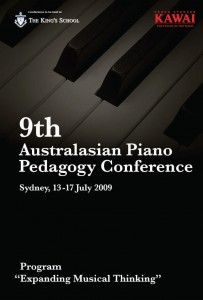
[…] 9th Australasian Piano Pedagogy Conference, Sydney, 13-17 July, 2009. This year, in the magnificent surroundings of the King’s School, North Parramatta, the biennial conference brings together pianists, students, teachers and scholars from Australia, New Zealand, US, Canada, UK, Hong Kong and Italy for wideranging discussions of issues in piano pedagogy and the interpretation of piano repertoire. […]
ABSTRACT In this brief look at contemporary piano music repertoire I shall try and answer the following questions: a) Is it possible to introduce the language and performance of contemporary music from the very first years of study? b) What educational purpose does this serve? c) What repertoire do we have available? I will first illustrate some examples of possible repertoire.Subsequently, given some prerequisites of an educational nature, I will examine some elements taken from an analysis of the pieces, highlighting their possible implications in a teaching environment, with the objective of demonstrating the pedagogical value of a repertoire which is still little adopted in the curriculum in the first years of study.
“CONTEMPORARY ART MUSIC: IS IT SO DIFFICULT? REFLECTIONS FROM PIANO LITERATURE FOR CHILDREN”

ABSTRACT Contemporary music is more and more considered as addressed to experts because difficult to listen to, to be understood, and to be played. The difficulty seems to be an intrinsic characteristic of this repertoire. This perception conditions instrument teachers to choose to address contemporary music in the advanced courses, considering it non-comprehensible by the young pupils and, technically, too complicated. After all, composers often judge works for children a “minor” and too binding sphere. All this just increases the prejudice about music which is actually complex, but not necessarily difficult. […]
“THE CONTEMPORARY ART MUSIC IN THE TEACHING OF A MUSICAL INSTRUMENT”
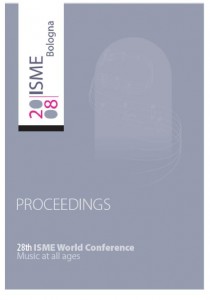
ABSTRACT This paper relates the experiences garnered in some seminars held by the author at the Conservatory “G.Tartini” in Trieste, Italy. The seminars were directed toward future piano teachers to increase their knowledge of contemporary art music and to make them reflect about their approach to teaching. At the end of the article, some data are reported with reflections about why the young performers’ syllabus is often lacking this type of repertoire.
